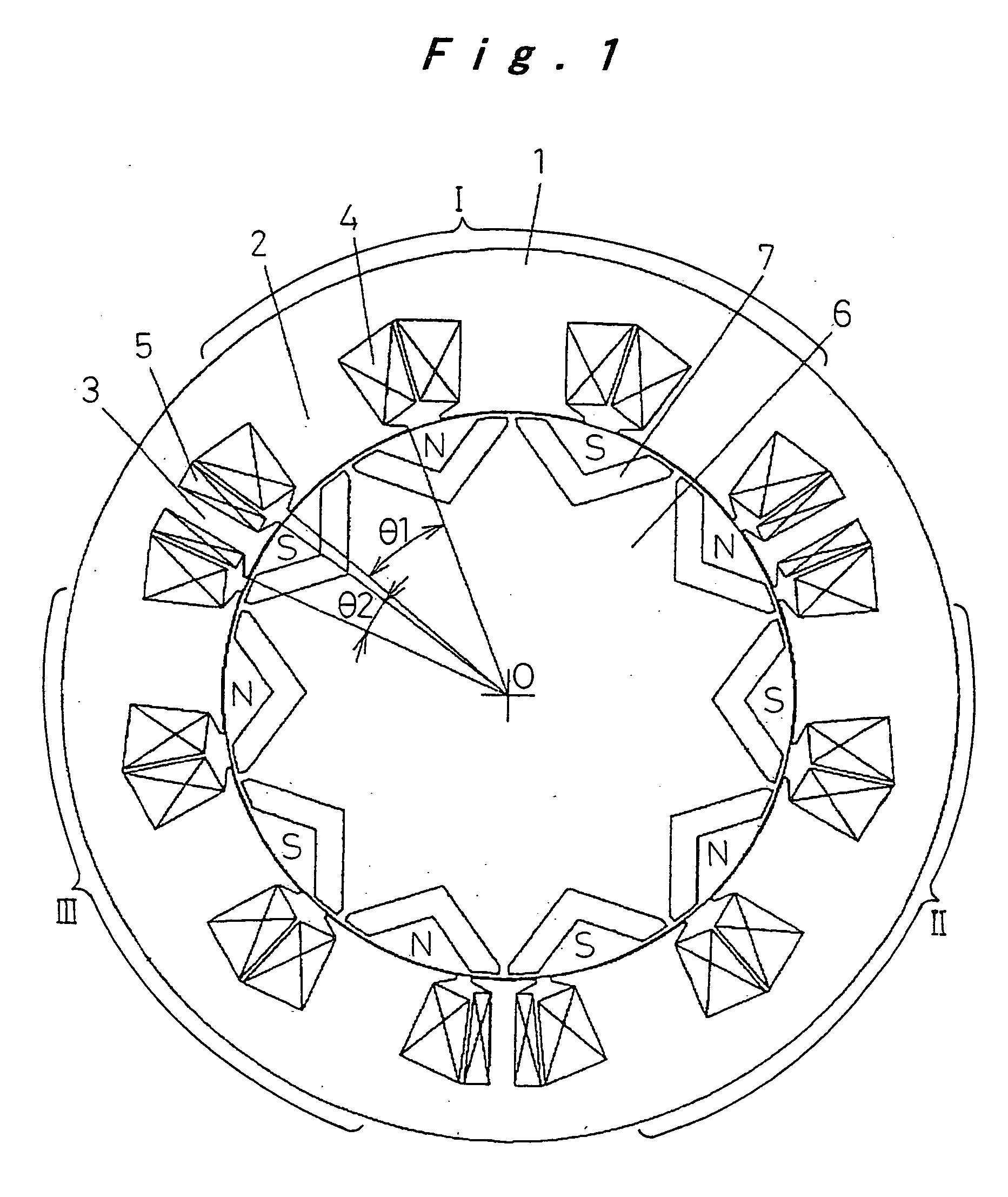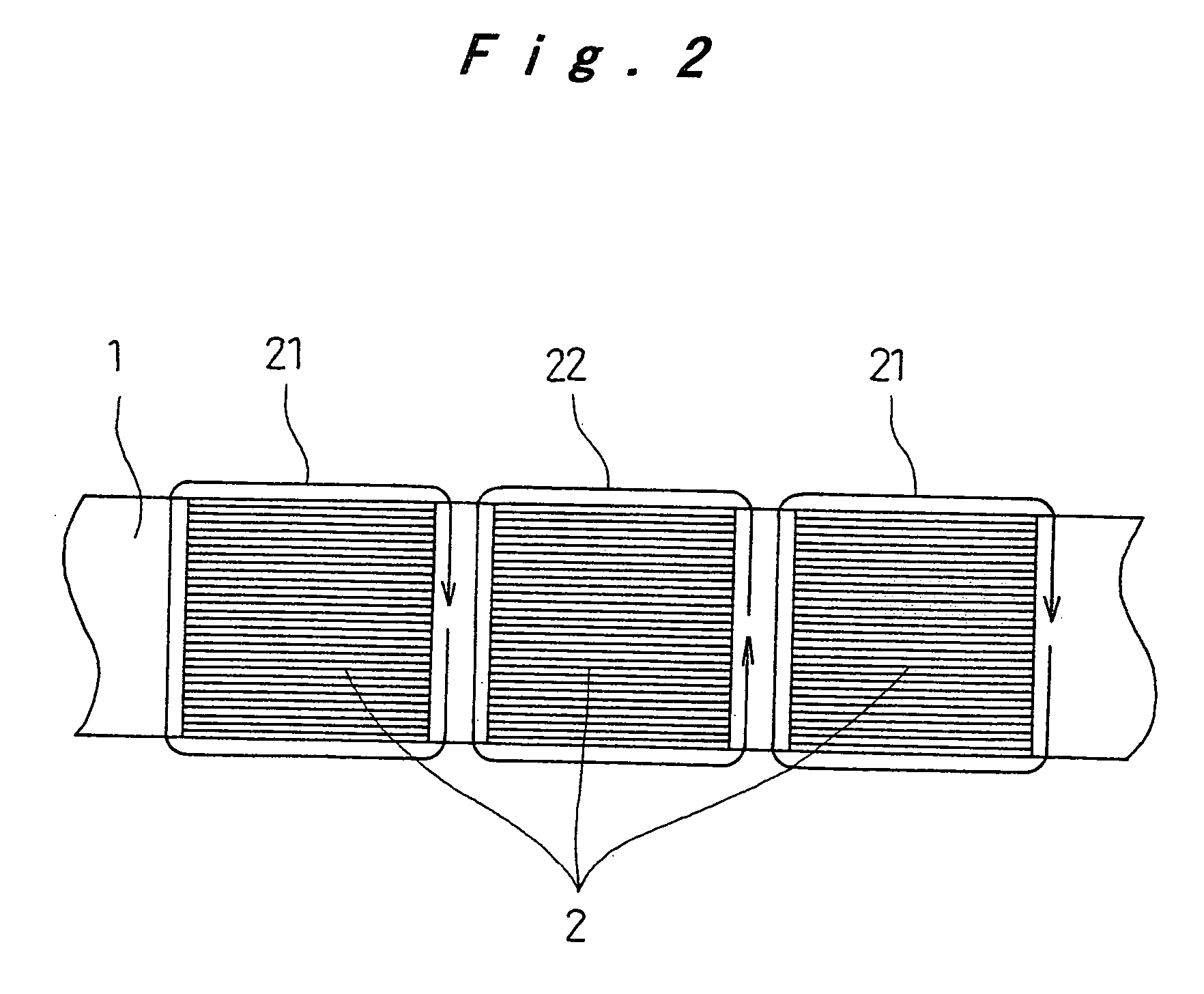Motor generator
a motor generator and motor technology, applied in the direction of synchronous generators with multiple outputs, hybrid vehicles, battery/fuel cell control arrangements, etc., can solve the problems of increasing the physical size of the motor generator, increasing the cost of associated equipment, and increasing the mounting space. , to achieve the effect of low cost, improved utilization of interior space, and low cos
- Summary
- Abstract
- Description
- Claims
- Application Information
AI Technical Summary
Benefits of technology
Problems solved by technology
Method used
Image
Examples
first embodiment
(First Embodiment)
FIG. 1 through FIG. 3 are figures describing a motor generator according to a first embodiment of the present invention, wherein FIG. 1 is a cross-sectional view showing the main elements of a motor along a cross section perpendicular to the central rotational axis, FIG. 2 is a development view describing the winding direction of the windings on the teeth of the first winding groups, and FIG. 3 is a connection diagram showing the state of the connections between the first and second winding groups.
In FIG. 1, a stator core 1, formed from laminated electromagnetic steel plate, is equipped with teeth 2 around which first winding groups 4 are wound, and teeth 3 around which second winding groups 5 are wound. On the other hand, permanent magnets 7 are embedded in a rotor core 6 formed from laminated electromagnetic steel plate, thereby forming a rotor, and are arranged about the center of rotation 0 in a freely rotatable manner, leaving a slight gap between the perman...
second embodiment
(Second Embodiment)
FIG. 5 and FIG. 6 are figures for describing a motor generator according to a second embodiment of the present invention, wherein FIG. 5 is a schematic cross-sectional view of the stator core and the rotor which opposes the inside peripheral surface of the core, along a surface perpendicular to the central rotational axis, and FIG. 6 is a partially enlarged view describing the shape of the teeth which constitute the stator core.
As shown in FIG. 5, a stator core 31 comprises first teeth 32 wound with first winding groups 34, and second teeth 33 wound with second winding groups 35, in the same manner as the first embodiment described above. There are a total of nine first teeth 32 around which the first windings 34 are wound, which are divided into three groups, group I to which U phase voltage is applied, group II to which V phase voltage is applied, and group III to which W phase voltage is applied, and the second teeth 33 around which are wound the second windi...
third embodiment
(Third Embodiment)
FIG. 7A through FIG. 7C are figures for describing a motor according to a third embodiment of the present invention, and are schematic top plan views showing the stator core.
As shown in FIG. 7A, a stator core 51 comprises first teeth 52 wound with first winding groups 54, and second teeth 53 wound with second winding groups 55, in the same manner as for the first embodiment described above. There are a total of nine first teeth 52 around which the first windings 54 are wound, which are divided into three groups, namely group I to which U phase voltage is applied, group II to which V phase voltage is applied, and group III to which W phase voltage is applied, and the second teeth 53 around which are wound the second windings 55 are provided between the groups I, II, and III. Furthermore, in the same manner as for the first embodiment described above, the winding direction of the first winding groups 54 which are wound around the first teeth 52 in the groups I, II,...
PUM
 Login to View More
Login to View More Abstract
Description
Claims
Application Information
 Login to View More
Login to View More - R&D
- Intellectual Property
- Life Sciences
- Materials
- Tech Scout
- Unparalleled Data Quality
- Higher Quality Content
- 60% Fewer Hallucinations
Browse by: Latest US Patents, China's latest patents, Technical Efficacy Thesaurus, Application Domain, Technology Topic, Popular Technical Reports.
© 2025 PatSnap. All rights reserved.Legal|Privacy policy|Modern Slavery Act Transparency Statement|Sitemap|About US| Contact US: help@patsnap.com



